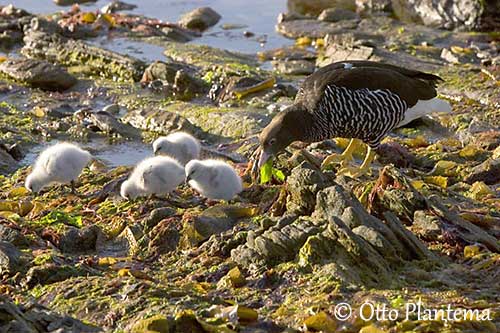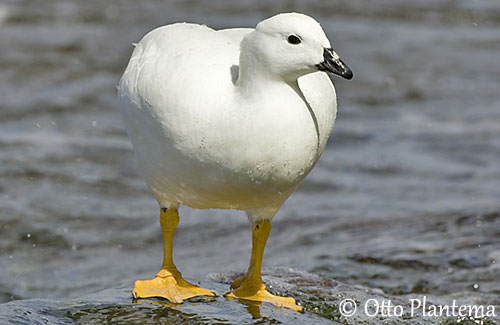
PROTECTION / THREATS / STATUS:
The Kelp Goose has stable populations due to inaccessibility of its habitat. They do not suffer disturbance, and there is no evidence of significant threats.
The species is currently classified as not threatened, but trends are unknown.
Fr: Ouette marine
All : Kelpgans
Esp : Caranca, Cauquén Caranca, Ganso del cachiguyo
Ita : Oca del Kelp
Nd : Kelpgans
Sd : Kelpgås
Photographers:
Eduardo Andrés Jordan
MIS AVES – AVES DE ARGENTINA
Otto Plantema
Trips around the world
Text by Nicole Bouglouan
Sources:
HANDBOOK OF THE BIRDS OF THE WORLD vol 1 by Josep del Hoyo-Andrew Elliot-Jordi Sargatal - Lynx Edicions - ISBN: 8487334105
GUIDE DES CANARDS, DES OIES ET DES CYGNES – de Steve Madge - Delachaux et Niestlé - ISBN: 2603013769
BirdLife International (BirdLife International)
Kelp Goose
Chloephaga hybrida
Anseriformes Order – Anatidae Family
INTRODUCTION:
Male and female are totally different with all white male and dark barred female. The name of this species is closely related to its favourite food, the kelp, found on marine coasts where it is living.
DESCRIPTION OF THE BIRD:
Biometrics:
Length: 55-65 cm
Weight: M: 2600 g – F: 2040 g

The adult female has blackish-brown mantle, upper back, scapulars and tertials. The upperwing-coverts are white, except the blackish greater coverts showing green gloss. Primaries are blackish. Rump, uppertail-coverts and tail are white.
On the underparts, the brown breast and flanks are barred white, due to white-edged feathers. Belly, undertail-coverts and tail are white. On the white underwing, primaries are blackish.
Head and neck are dark brown, with slightly paler crown. The bill is pale pink to pinkish-yellow. The eyes are dark brown, surrounded by white eyering. Legs and webbed feet are yellow.
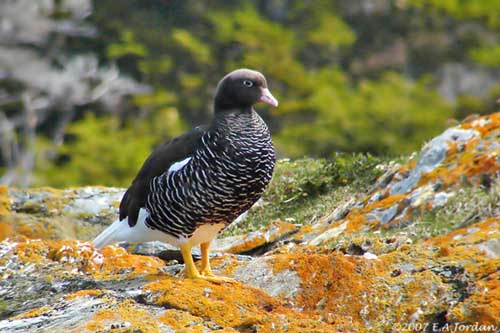
The juvenile resembles adult female but its plumage is duller. It lacks the green gloss on greater coverts. It has indistinct barring on underparts, and blackish spots on belly, uppertail-coverts and back.
The young male shows very soon white feathers on head, neck and breast. The white adult plumage appears through the second year, with only dark tips to the primaries. Legs and webbed feet are dull greenish-yellow.
SUBSPECIES AND RANGE:
We can find two subspecies, both displayed on this page.
C.h. hybrid or Lesser Kelp Goose is found in S Chile, Tierra del Fuego.
C.h. malvinarum or Greater Kelp Goose occurs on Falkland Islands. This one is larger, especially conspicuous in bill.
HABITAT:
The Kelp Goose is usually seen along the rocky coasts and on shingle beaches. This species breeds on coastal freshwater lakes, or in shrubs and tall grass behind the beaches.
CALLS AND SONGS: SOUNDS BY XENO-CANTO
The Kelp Goose is not very vocal. The male gives a repeated, tiny, weak whistle “sip sip sip”, whereas the female produces an ascending grunt and raucous snarling notes.
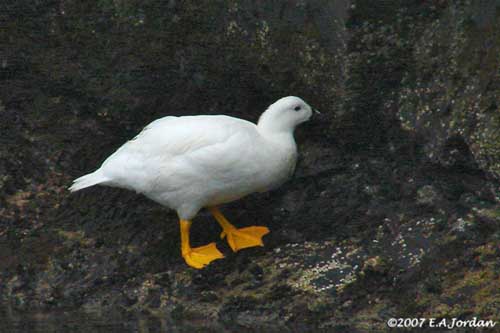
BEHAVIOUR IN THE WILD:
The Kelp Goose feeds exclusively on plant matter, taking primarily filamentous algae (Enteromorpha), sea lettuce (Ulva) and leafy algae (Porphyra), found on tidal rocks.
It forages along the coastline, but also on its breeding grounds where it feeds on green grasses. It also takes berries during winter.
It is usually seen in pairs or family groups. They frequent sometimes freshwaters for drinking and bathing, at about one kilometre from the coast.
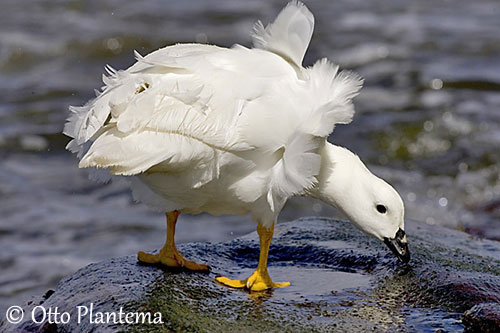
The breeding season starts in October/November. The Kelp Goose has long-term pair-bonds and remains paired for life. Some displays probably occur, and between yet paired birds, they only affect these two birds. Displays are performed in front of other birds, and consist of ritualized postures.
After the breeding season, they gather in large numbers (up to 300) for moulting. They are flightless during several weeks.
The continental race “hybrida” appears relatively sedentary, and only performs short winter movements along the Chilean coast and up Atlantic coast of Argentina.
The race “malvinarum” is sedentary on Falkland Islands.
These geese living along coastal waters do not need to fly, but they can fly very short distances occasionally.
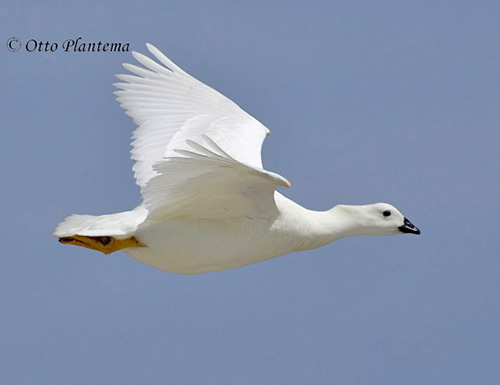
REPRODUCTION OF THIS SPECIES:
The laying occurs between late October and early November. The Kelp Goose breeds in solitary pairs or loose groups. The nest-site is situated on low rocky outcrops or on the ground among bushes and tall grass.
The nest is made with grasses and lined with breast feathers. It is concealed among vegetation, often behind the beach.
The female lays 3-7 creamy-white eggs. She incubates during one month, while the male remains in the close vicinity and protects her.
At hatching, the chicks are covered with white down. They leave the nest very soon, and are able to feed themselves. The adults lead them to good food sources and protect them. The chicks fledge in February, about 12-13 weeks after hatching, and become independent. They will be sexually mature at 2-3 years old.
